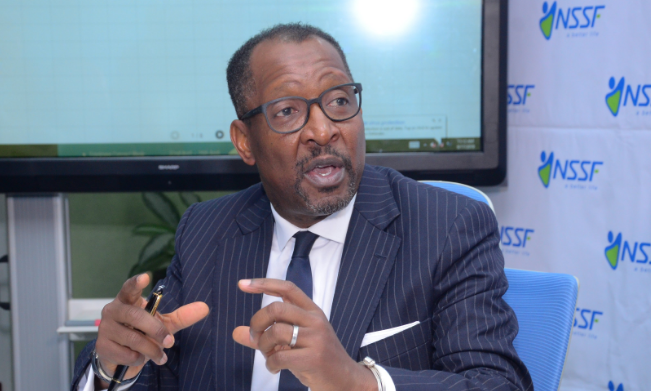The National Social Security Fund (NSSF) will pay a lower interest rate to its members for the financial year 2018/19 on account of a drop in its total income compared to the previous year, the Managing Director Richard Byarugaba has said.
According to Byarugaba, while the Fund’s revenue which includes interest, dividend and rental income increased by over 20 percent to Shs 1.3 trillion, overall income reduced by over Shs 402.8 billion due to a decline in regional equity prices and currencies.
“Our members should therefore expect a reduction in the interest rate this year compared to last year,” he said Byarugaba said in Kampala during a media dialogue where the Fund’s interim financial performance for the year 2018/19 was announced.
“I am extremely confident that the minister will declare a rate that will achieve and even surpass this target. Our members should be confident in the health of the Fund. In the short, medium and long term, the Fund remains financially stable and growing,” he said.
Dr. Gabriel Ajedra, State Minister of Finance for General Duties at the 6th NSSF Annual Member’s Meeting held in Kampala declared a record 15 (equivalent to Shs1.1 trillion) percent interest to members after an impressive performance on key financial indicators for the financial year 2017/2018.
However, Byarugaba said the Fund will for financial year 2018/19 still pay a competitive return, at least 2 percentage points above the 10-year average rate of inflation.
Generally, he said, the fund registered good performance in spite of the challenging economic environment, mainly the stock market volatility and foreign exchange deficits.
”The Nairobi Stock Exchange lost 14 percent, the Uganda local share index shade 10 percent while Tanzania plummeted by over 21 percent. The share prices closed below prices registered at end of the previous financial year, which impacted the performance of our equity portfolio,” he said.
Byarugaba said there was general depreciation of the regional currencies against the Uganda Shilling in the financial year under review. Both the Kenya and Tanzania currencies depreciated by 6.1 percent against the Uganda Shilling. For instance, he said the Kenya currency depreciated, falling from UShs37.97 at the start of the financial year to close just below UShs36.
Meanwhile, the amount of money paid in benefits increased by 25 percent to Shs450 billion in 2018/19 from Shs360 billion in 2017/2018.
The Fund’s assets increased by 13.1 percent to Shs11.3 trillion as at June 2019 from Shs 9.98 trillion in 2017/18. The increase was driven by increased contributions and interest income.
Annual contributions collections, according to the official, increased to Shs1.208 trillion in 2018/19 from Shs 1.049 trillion realised in the previous year, a 15 percent growth. The growth in contributions was driven by growth in the economy which increased the new members.
On the other hand he said the average benefits turn-around-time 2018/19 remained flat at 8 days while the compliance level based on 1 month is now at 61 percent.
Customer satisfaction slightly dipped by 1 percent from 85 percent in 2017/2018 to 84 percent in 2018/2019. “Our members love and want the product but would like to utilize midterm benefits,” he said, adding that staff engagement increased from 84 percent in 2017/2018 to 88 percent in 2018/2019.
He said during the period, headline inflation was stable as commodity prices and food prices remained stable due to improved weather conditions and oil gluts.
Uganda Inflation remained low at 3.4 percent and below the long-term target of 5 percent while the Uganda economy witnessed stable growth at 6.1 percent compared to 6.2 percent in the previous year. The growth, he said, was supported by an accommodative monetary policy stance, improvement in agriculture sector and growth in public infrastructure developments.








